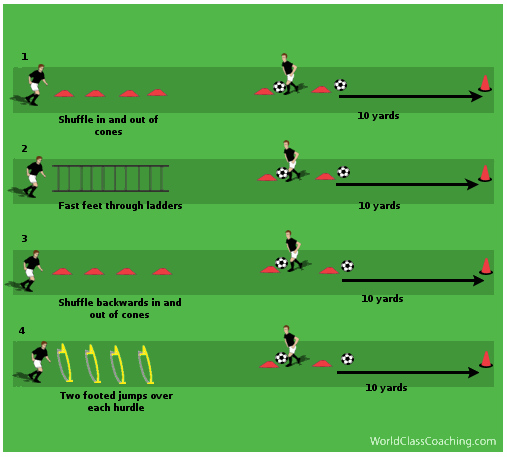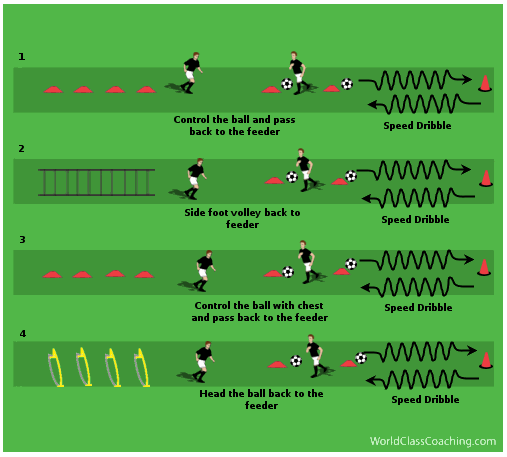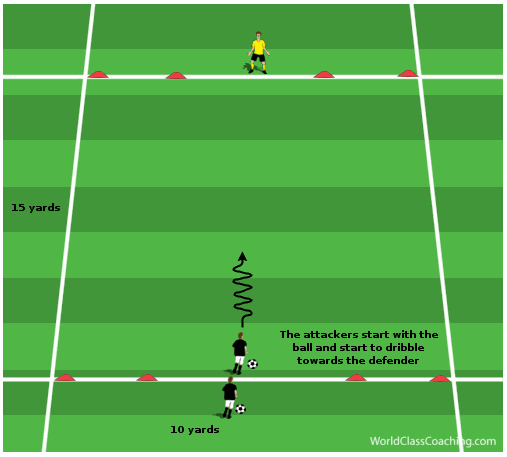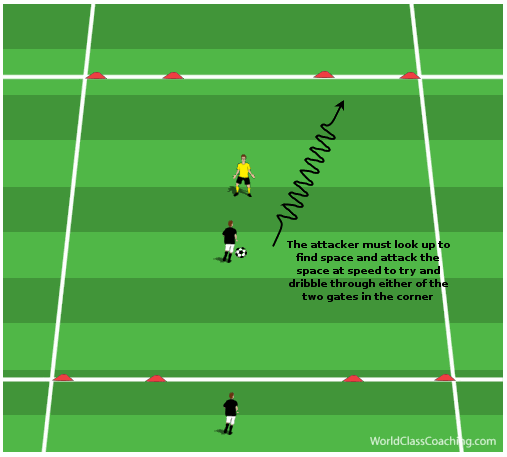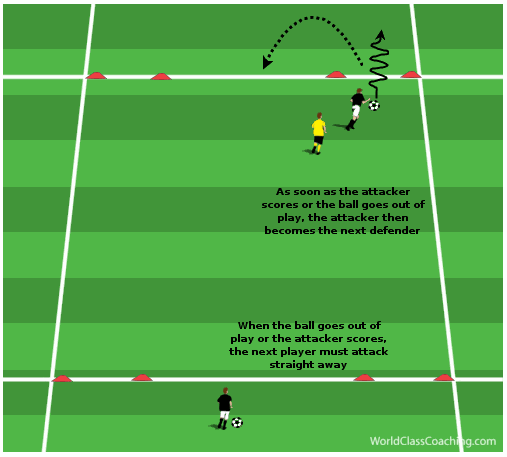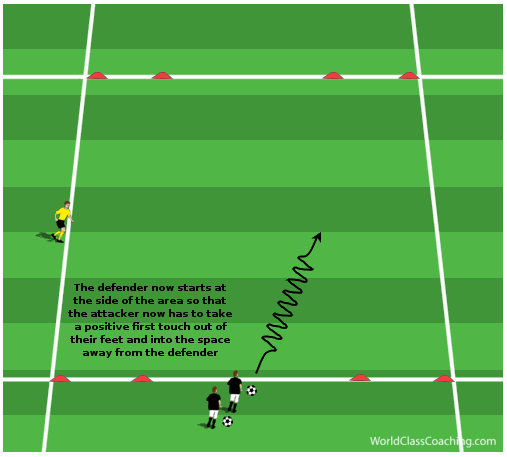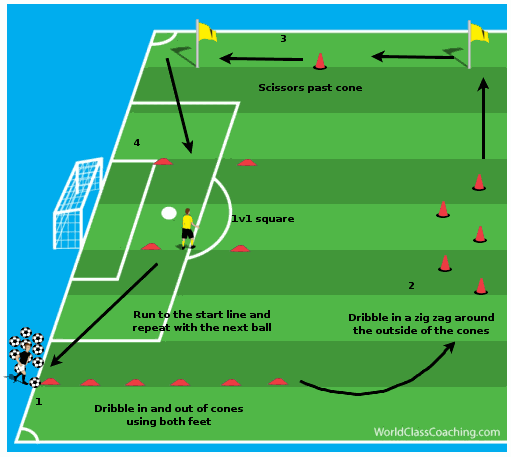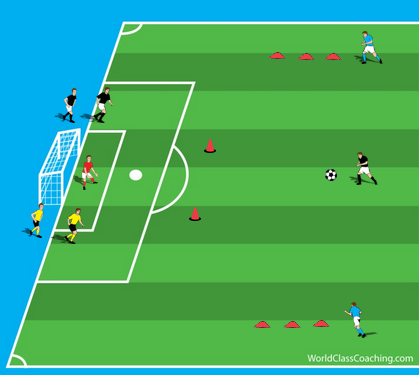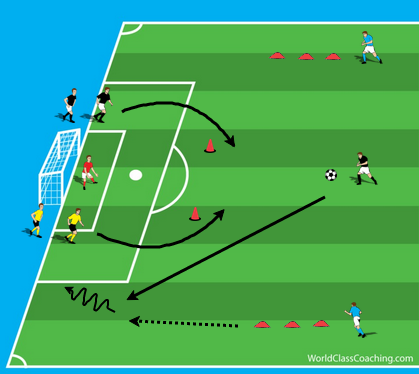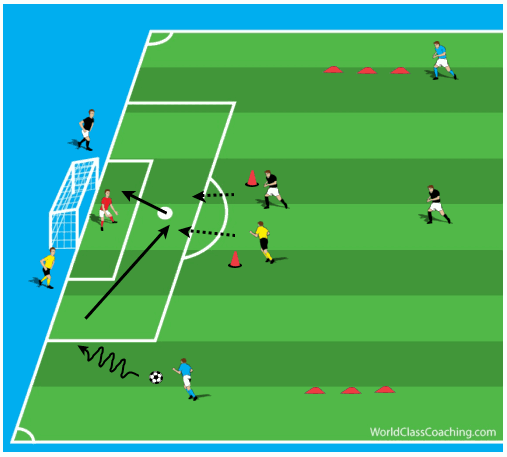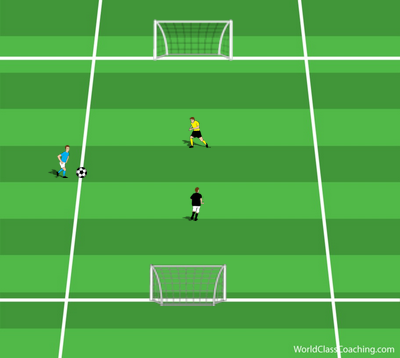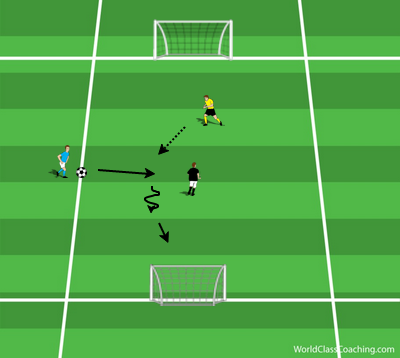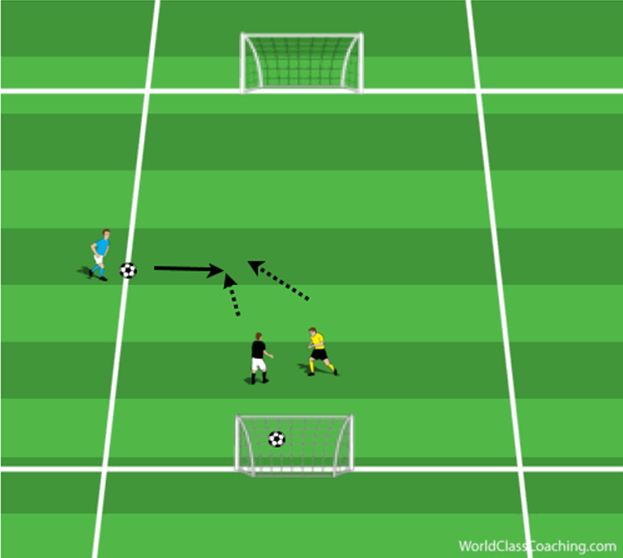Part Three
- Agility, First Touch and Speed Dribbling
- 1 v 1's With a Conditioning Element
- Dribbling Challenge With Endurance
- Racing to Finish the Cross
- Continuous 1 v 1 Battles
Agility, First Touch and Speed Dribbling
By Jebreel Bubtana
This exercise works on your player’s first touch, speed dribbling and endurance. This is another exercise that can work very well with your team for preseason training.
There are 4 stations as shown below (figure 1), with your players spending 5 minutes at each station before moving onto the next.
Station 1:
The player must shuffle in and out of the cones before receiving a pass from the feeder. The ball must be controlled with the inside of the foot and passed back. As soon as this is done, the player must sprint to the ball behind the feeder and speed dribble around the tall cone and stop the ball where the speed dribble started (figure 2). The two players switch roles and keep doing so until the coach calls time.
Station 2:
The player must run through the ladders placing both feet in the gaps of the ladder. The feeder at this station starts with the ball in their hands and throws the ball to their partner who will perform a side foot volley back into their partner's hands. After this has been done, the player must sprint to the ball behind the feeder and speed dribble around the tall cone and stop the ball where the speed dribble started (figure 2).The two players now switch roles and continue until the coach calls time
Station 3:
The player must shuffle backwards through the cones and then turn to face their partner. The feeder at this station starts with the ball in their hands and throws the ball to their partner who will control the ball with their chest and pass it back to their partner. After this has been done, the player must sprint to the ball behind the feeder and speed dribble around the tall cone and stop the ball where the speed dribble started (figure 2). The two players now switch roles and keep doing so until the coach calls time.
Station 4:
The player must perform two footed jumps over each hurdle. The feeder will now throw the ball high in the air and their partner must head the ball back into their hands. After this has been done, the player must sprint to the ball behind the feeder and speed dribble around the tall cones and stop the ball where the speed dribble started (figure 2). The two players now switch roles and keep doing so until the coach calls time.
It is important to make sure that the intensity is kept to a maximum during this exercise ensuring that the players complete the stations as quickly as possible every time they go, especially as they have a little rest after every go when they switch with the feeder. Eventually fatigue will start to set into the players so it is important to emphasize that technique does not start to suffer when controlling, volleying or passing the ball. You could also increase the work load on the players by having them and the feeder stay in the same role for a set period of time rather than switch after every go. If you choose to do it this way then I would recommend 2 or 3 minutes in each role before moving onto the next station.
1v1's With a Conditioning Element
By Jebreel Bubtana
This exercise is a great way to have your players work hard and have fun at the same time. This helps to develop aerobic and anaerobic fitness as it involves many short sprints and changes of direction as well as recovering as a defender.
Split your team into groups of 3 and set up the field as shown below in figure 1.
The attacker starts with the ball must score in either of the two gates at the other end of the area (figure 2).
The 1v1 continues until the attacker scores by dribbling through either gate or the ball goes out of play. As soon as either of those things happens, the attacker becomes the new defender and the next attacker starts to dribble towards the gates (this ensures that everyone gets to play as an attacker and defender). The idea is that the next attacker does not wait for the new defender to get ready; they must attack as soon as the previous two players are done, which means that the new defender must recover quickly to close down the space for the attacker. This is to ensure that the intensity of the exercise is kept at a high level (figure 3). Also, if the defender wins the ball then they can attack the two gates at the other end of the area.
Coaching Points:
- The attacker must have their head up to see where the space is and attack that space at speed.
- When facing the defender, the attacker must not let the ball get too close to the defender. A quick decision must be made as to where to attack to avoid this.
- If the defender blocks off one of the gates then the attacker can turn and attack the other gate.
- A slightly bigger touch can be taken in order to get past the defender and run onto the ball at speed and into the space.
Progression:
The exercise is very much the same but the starting point for the defender changes. Now the defender is closer to the attacker and to one side. In order to beat the defender now, the attacker must decide where the space is away from the defender and take a positive first touch into that space and accelerate into that space to get away from the defender. The rotation of the players is the same after every go and must be done quickly as previously done.
Dribbling Challenge With Endurance
By Jebreel Bubtana
This dribbling challenge is a great way to have your players work on different dribbling techniques, whilst working on their endurance. The objective is to complete the challenge with 5 soccer balls as quickly as possible. Set up your field as shown below (figure 1).
There are 4 stations that your player/players must complete before getting the next ball and going again.
Station 1 – Dribble in and out of the cones using the inside and outside of both right and left foot. It is important that the player moves their feet quickly and keeps the ball close using small touches.
Station 2 – Dribble in a zig zag around the outside of each cone. As the player goes around the outside of a cone they can use the inside of their right or left foot and cut inside towards the next cone. Again small touches will ensure that the ball is kept under close control at all times. After they have done this they dribble towards the flag and cut inside towards the next station. To get there as quick as possible the player can use bigger touches so that they can build up some speed to get to the next station.
Station 3 – Perform the scissors move to get past the cone. The player must ensure that they perform the move at a good distance away from the cone so that they do not hit it (in a real game this would be a defender and if they hit the cone it is like the defender winning the ball). After this is done the player must dribble around the flag and towards the next station.
Station 4 – The last station is a 1v1 square. The player must make sure that they attack the space as quickly as possible to get past the defender.
As soon as they beat the defender they run to the starting point and get the next ball to perform the circuit again. This exercise is timed and the player must go around the circuit 5 times to complete the challenge. This is a great way to get your squad competing against each other and can create healthy competition.
Variations
You can create your own challenge and change some of the dribbling techniques through the circuit, for example, you may want to change the 2nd station so that the player uses the sole of both feet to complete the station. Be creative!
Racing to Finish the Cross
By Daniel Severn
This week we focus on speed and agility combined with crossing and finishing under pressure. The exercise works best when run as a competition as this adds extra motivation for the players. Speed and Agility are obvious essentials in any game of soccer as players in any role or position on the field will benefit from having good speed and being more agile. The crossing and finishing aspects are more honed towards specific positions, so depending on the situation of your team, (whether you rotate players in positions or if your players have set positions) you can work a little bit of positional specific training into this exercise, especially for your outside defenders and midfielders. A good warm up should be performed before this exercise as it is played at a very high tempo.
Set Up and Directions
The exercise is set up as shown below with the coach positioned centrally around 30 yards from goal. The coach must have a supply of soccer balls to keep the exercise fluid. We also have two wide players, positioned on each wing. Each will have three cones laid out in front of them which they will use to perform agility. The wide players will act as neutrals and should try to play crosses into general areas, trying not to favor a team, but giving the players a good chance to score from the cross. Two teams will line up on opposite sides of the goal (minimum two players per team) with a goalkeeper in the goal.
Play begins with the coach playing a pass out to either wing (left wing in the example below), the winger then shuffles through the cones as quickly as possible and then sprints forward to retrieve the pass before dribbling towards the end line.
At the same time, the attacker at the front of each line will sprint out towards the cones positioned just outside the penalty box, before turning back through the gate, as shown below.
The wide player will then play a low cross into the penalty area, being sure to keep the cross away from the goalkeeper (preferably a diagonally cut-back cross) and the two strikers compete to score against each other and the goalkeeper.
To encourage the players to go as quickly as possible, I award 3 points for a ‘first-time finish’ and 1 point for a regular goal (with a touch to control, or dribbling before a shot). If they manage to get to the cross just ahead of their opponent, then they can finish quickly without too much pressure. If they get there around the same time as the opponent, then they will be put under pressure and will usually need to control the ball before shooting or trying to get past the defender to shoot.
Timing
The timing of the exercise can be varied easily as you can continue adding many variations (shown below). The players should be encouraged to work at a high tempo throughout.
Variations
- Agility– quick feet; shuffling; backwards etc.
- Coaches Pass – the coach could play a high pass into the corner to be retrieved by the wide player, this makes the first touch more difficult for the wide player and therefore becomes more challenging.
- Crossing – you could choose to work on crosses in the air from this situation also.
- Number of players – you could add a second player for each team and play 2v2 to goal from the cross.
I hope you enjoy the exercise!
Continuous 1v1 Battles
By Daniel Severn
This week we have a very high tempo, quick-fire 1v1 exercise that is worked in groups of three. It is always good to practice 1v1s they happen all over the field in every single game. 1v1s also get players thinking from both the attacking and defensive side of the game. A good warm up should be performed before this exercise as it is played at a very high tempo.
Set Up and Directions
The exercise is set up as shown below. The feeder ( player in blue on the outside of the field) must have a number of soccer balls available in order to keep a high tempo for this game. The two active players wait centrally in the 20x15 yard field marked out with two goals, one at either end.
Play begins with the feeder playing a pass directly between the two competing players. The two players then compete for possession. The player that wins possession must try to dribble away from their opponent in order to create enough space to take a shot and score on either goal.
Shooting towards both goals helps encourage awareness of surroundings and individual creativity e.g. faking towards one goal, causing the defender to move, and then turning back towards the opposite goal.
As there is lots of opportunity to score here, we play seven rounds with the same two players in the middle.
As soon as one ball goes out of bounds OR in the goal, the feeder plays the next ball directly between wherever the two competing players are on the field at that time.
This allows very little rest-bite for the players and keeps a very high tempo.
After seven round of play, you should have a winner…if not, then you can play one more ‘tiebreaker’ round. The winner stays on and the losing player now becomes the feeder.
Be sure to reset the soccer balls each time you change feeders so that the new feeder can help keep a flow of passes into the area.
Timing
The timing of the exercise can be varied depending on the conditioning level of your players and by using some of the variations shown below. The players should be encouraged to work at a high tempo throughout.
Variations
Feeder– throw the ball in high every time OR play a pass to the opposite side of the field to where the two players are.
Direction – play with a goal to defend and a goal to attack for each player, this is more game realistic and adds more of a defensive element to the game also.
Number of players – you could add a second player for each team and play 2v2 to goal.
I hope you enjoy the exercise!

